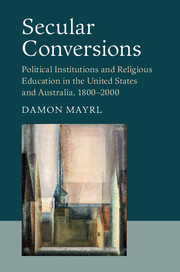 Secular Conversions
Secular Conversions Book contents
- Frontmatter
- Contents
- List of Figures and Tables
- Acknowledgments
- List of Acronyms
- Introduction
- 1 Politics, Institutions, and Secularization
- Part I Forging the nineteenth-century settlement
- Part II The nineteenth-century settlement in transition
- 3 Slow Secularization in the Permeable American State
- 4 Settlement Stability in the Insulated Australian State
- Part III Forging the twentieth-century settlement
- Part IV Implications
- Epilogue: Toward a Twenty-First-Century Settlement?
- Index
3 - Slow Secularization in the Permeable American State
from Part II - The nineteenth-century settlement in transition
Published online by Cambridge University Press: 05 August 2016
- Frontmatter
- Contents
- List of Figures and Tables
- Acknowledgments
- List of Acronyms
- Introduction
- 1 Politics, Institutions, and Secularization
- Part I Forging the nineteenth-century settlement
- Part II The nineteenth-century settlement in transition
- 3 Slow Secularization in the Permeable American State
- 4 Settlement Stability in the Insulated Australian State
- Part III Forging the twentieth-century settlement
- Part IV Implications
- Epilogue: Toward a Twenty-First-Century Settlement?
- Index
Summary
INTRODUCTION
In December 1872, the Ohio Supreme Court ruled that the Ohio state constitution did not “enjoin or require religious instruction, or the reading of religious books, in the public schools of the state.” Its decision, which brought to a close four years of wrangling in response to the Cincinnati school board's decision to prohibit the reading of the Bible in that city's schools, represented the first time in American history that a court had upheld the removal of religious instruction from the public schools. For good reason, therefore, scholars have hailed the decision as “a watershed” that “forever changed the way people looked at nonsectarian Bible reading.” Yet the substantive and symbolic importance of the decision has often overshadowed its key holding: the importance of respecting the prerogative of the Cincinnati school board to make its own decisions regarding religious instruction. “The legislature having placed the management of the public schools under the exclusive control of directors, trustees, and boards of education,” the Court reasoned, “the courts have no rightful authority to interfere by directing what instruction shall be given, or what books shall be read therein.” This great symbolic blow against public school devotionals, in other words, rested upon a legal defense of local control.
During the late nineteenth and early twentieth centuries, local control was crucial to determining the course of secularization in the United States. The decentralization of educational policy authority meant that religious practices varied widely around the country. This fragmentation in turn facilitated the advance of two key secularizing processes, religious conflict and professionalization, leading to a slow decline in the prevalence of religious instruction in the public schools. Local control meant that religious practices had to be responsive to local, not statewide, political dynamics. In religiously heterogeneous areas, religious minorities – especially Catholics and Jews – were able to challenge the pan-Protestant devotional exercises by lobbying local boards to change their policies. Where they commanded significant political power, religious minorities could leverage their local strength to effect compromises or outright eliminate the offending practices. Further, over time, these ongoing conflicts over Bible reading and other religious practices created a climate in which school boards came to perceive religion as being dangerously controversial, generating a new conventional wisdom among administrators that eschewed religion in the interest of political harmony.
- Type
- Chapter
- Information
- Secular ConversionsPolitical Institutions and Religious Education in the United States and Australia, 1800–2000, pp. 81 - 119Publisher: Cambridge University PressPrint publication year: 2016


